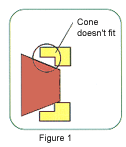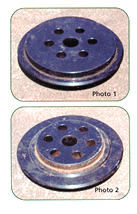Your career path may steer you toward the tire selling business. Should you travel that road and spend time balancing tires and wheels on various vehicles – from small performance and tuner cars to medium and heavy-duty trucks and all the way up to the big rigs – there are some important issues to consider.
Let’s say you’ve just sold that $2,500 set of tires and wheels. Congratulations! Of course now you have to make sure that the assembly is properly balanced, or you’ll be seeing that customer more often – and for the wrong reasons.
One way to improve your service skills is to attend tire/wheel balancing clinics when opportunities arise. In this article, we will provide you some balancing tips. Some of these you may have studied and performed, others are some not-so-obvious balancing issues.
Start With The Basics
We’ll first address passenger vehicles, then on page 12, we’ll highlight commercial vehicle tire/wheel balancing. Now, pay attention because what is explained here will really save you a lot of headaches – make sure the mounting pad of the wheel is completely clean and free of debris. Make sure the balancer hasn’t accumulated any dirt as well. It takes only .002 to .005 inches (the thickness of a business card) to cause a “0” balanced assembly to be off by 1.5 ounces. Cones need to fit the shaft without any slack. If you haven’t inspected your balancer cones recently, you might be surprised how loose they are due to wear.
 Now for a pop quiz: When you’re ready to balance the assembly, do you place a cone on the front or back of the centerbore? Look closely at the wheel. The front is flat and doesn’t even touch the vehicle’s hub. The rear of the centerbore is machined with a slight angle to allow the cone to center the wheel.
Now for a pop quiz: When you’re ready to balance the assembly, do you place a cone on the front or back of the centerbore? Look closely at the wheel. The front is flat and doesn’t even touch the vehicle’s hub. The rear of the centerbore is machined with a slight angle to allow the cone to center the wheel.
So the best procedure is to cone from the rear and use a flange plate adapter that will press against the lug holes and apply the same amount of pressure evenly around the wheel. These adapters are distributed by several companies, so check your local supplier for them.
Bump-N-Grind
Computerized balancers for consumer tires/wheels are extremely sensitive to vibration and movement. They “feel” movement in the assembly and calculate the amount of weight needed to counterbalance.
How many of us have ever thought of this?
If you don’t believe it, try it yourself. Balance an assembly to zero. Spin it again, but this time, lightly bump the balancer. What were the results?
This occured during a balancing clinic. When demonstrated to the class, you could have heard the proverbial pin drop. More than 50 people witnessed a balanced assembly come up asking for 1.50 ounces on the front and another 1.75 ounces on the rear, and all the instructor did was tap the balancer with his hand.
How many of you have accidentally bumped the balancer while waiting for the readings to appear? Take it a step further. How many of us have a portable stereo or car stereo that produces a deep bass tone that could be detected by the balancer? Even a loud exhaust can be detected and cause a bad result.
Problem Pickups
You may find yourself fighting a 3/4-ton or one-ton truck to get it to ride right. The reason is that the centerbores on the newer trucks are not always cut true. Many are slightly egg-shaped, so a cone won’t work to balance the assembly.
After a lengthy probe into the problem, a solution was found. It involves using a special two-sided adapter plate – in this case built by a wheel balancer manufacturer – that fits into the centerbore of the wheel (see Photos 1 and 2).
Using these plates, a specific procedure must be followed to make the assembly balance:
- Remove the tire/wheel from the truck with the valve stem in the 12 o’clock position. Do this for either steel or aluminum wheels.
- Put the adapter into the centerbore and place on the balancer. Tighten it up. Rotate the entire assembly so that the valve is in the 12 o’clock position. Loosen the wing nut slightly and let the wheel settle. Tighten back up and balance.
- Return the assembly to the truck with the valve in the 12 o’clock position and securely fasten the lug nuts.
It sounds strange, but it works.
Big Car Quandaries
The next item to discuss is wheels that have a step bore (see Figure 1 on page 8). The rear centerbore is machined at one diameter, then drops to a smaller diameter just inside the centerbore. For this reason, a GM short cone was developed. It works on the large FWD GM cars (Park Avenue, Delta 88). Chrysler’s LH and Concorde share similar designs, as do some aftermarket wheels.
If you see a step bore, make sure that your cones don’t touch these step bores or the mounting pad will not touch the balancer.
 With the flange plate fingers, you’ll need an extra long set for wheels on Nissan Frontiers and an extra narrow set for some-tuner-style wheels. If you’re upgrading to a flange plate adapter, make sure that you replace the shaft. Many old shafts were tapered on the end to allow the cone to slip on easier. The flange plate adapter needs a shaft that is consistent in its diameter.
With the flange plate fingers, you’ll need an extra long set for wheels on Nissan Frontiers and an extra narrow set for some-tuner-style wheels. If you’re upgrading to a flange plate adapter, make sure that you replace the shaft. Many old shafts were tapered on the end to allow the cone to slip on easier. The flange plate adapter needs a shaft that is consistent in its diameter.
Big Rig Balancing
Now let’s take a look at balancing commercial tires. You may ask yourself, so what if a line haul driver can’t feel the vibration?
Well, you’ll learn that taking a pass on balancing truck tires is a big mistake for fleets, for drivers and, ultimately, for dealers.
Following the flow of technology will help you with fleet customers. If you save them money, they’ll love you for it. Foul up and you’ll hear about it. If you don’t already know it, fleet customers also want you to suggest new ways for them to save money.
Here’s a good one. Tell them why they need to properly balance their drive and trailer tires. Fleets do a good job with the steer axle tires, if only because their drivers can feel any imbalance in the steering wheel, but most haven’t adopted the practice of balancing the remaining 16 tires.
The assumption is that a heavily loaded truck will dampen any vibration. That’s just not true and fleet owners who aren’t balancing all 18 tires are sacrificing more than just ride quality.
Runout Still There
While it’s true that tiremakers are providing safer, more reliable, longer-lasting medium truck tires than ever before, radial runout remains a sore point. So the job of managing and understanding the problems caused by this condition falls to you.
First, you need to understand that a pair of zeroes on a balancer (inner and outer planes) does not mean you’ve properly balanced the tire/wheel assembly. Your job isn’t over until you center the assembly on the vehicle the same way it was centered on the balancer.
Nor does it mean you’ve gotten rid of a built-in vibration problem created by a tire or wheel that isn’t perfectly round. There is still work to do.
Make sure you’ve mounted the tire/wheel assembly on the balancer properly. A truck tire/wheel assembly that is 43-plus inches in diameter and weighs about 250 pounds will have more than several ounces of imbalance when mounted off center by as little as 0.005 of an inch.
Follow the Fundamentals
- The first secret to balancing medium truck tires is to make certain you are mounting the tire/wheel assembly on the vehicle exactly the same way you mounted it on the balancer. Replication is vital, and more so with truck tires than with their smaller cousins.
- You can help minimize radial runout by mounting the high spot of the tire (indicated by a paint dot on the sidewall) to the low spot on the wheel (indicated by a dimple). If you can’t find the dimple, use the valve stem opening as your reference point.
- Don’t mount the tire dry, use proper lubrication. The bead must seat properly on the rim. Also important, don’t limit the use of lubricant to the tire alone. If you see a hump on the wheel that looks like a problem, put lubricant on it to facilitate a better mounting job. But don’t overlubricate or you’ll have wheels spinning loosely and tearing up beads.
- When mounting medium truck tires, more errors occur with demountable and stud pilot wheels than hub pilot wheels. That’s because the inner cap nuts may not have bottomed out all the way, and are improperly seated. Look for dirty threads and make sure that torque specifications have been carefully followed.
- Demountable wheel clamps can also contribute to a centering and/or vibration imbalance problem. A tire/wheel mounted in this manner will wobble. That sets up a scuffing motion which causes an irregular wear pattern and creates a vibration in the vehicle. Worse, the driver, isolated in the cab, will not feel any of this. You’ll have to eyeball the tire and read the signs of irregular wear to diagnose this problem.


